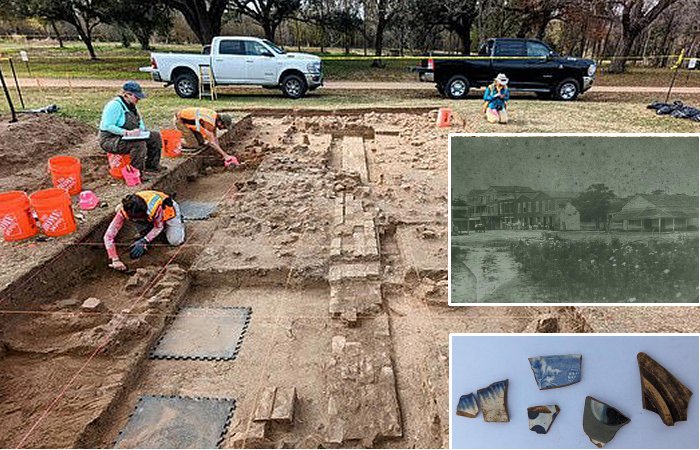Jan Bartek - AncientPages.com - While excavating on excavation the banks of the Brazos River in southeastern Texas, archaeologists have uncovered more than 10,000 artifacts from Washington-on-the-Brazos, a town remembered as the “Birthplace of Texas,” where the Texas Declaration of Independence was signed on March 2, 1836.
An image captured circa 1860 presents a view of Washington on the Brazos, featuring a line of towering brick edifices and various other constructions located to the south of Independence Hall. Courtesy of Jonathan Failor, Washington on the Brazos State Historic Site
As previously explained on Ancient Pages, "the modern city of Houston, Texas, is named after General Sam Houston, who led his troops to victory against Mexicans at the Battle of San Jacinto in 1836. The heroic Battle of the Alamo symbolized Texans’ resistance and fight for independence.
On April 21, 1836, everything changed, but this time in favor of the Texans. President Sam Houston (1793 -1863) led about 800 Texans against Santa Anna’s Mexican force of 1,500 men at San Jacinto. While shouting “Remember the Alamo” the Texan army attacked and defeated the Mexican forces. The victory at San Jacinto ensured the success of Texan independence."
The large number of artifacts unearthed at Washington-on-the-Brazos, a deserted town once home to 1,000 inhabitants, provides insightful glimpses into the lives of early Texans. This discovery paints a vivid picture of their existence shortly after Texas secured its independence from Mexico in 1836.
Archaeological digs have revealed the foundation of a brick fireplace, indicating the former location of a tavern. Credit: Laura McKenzie/Texas A&M Division of Marketing & Communications
Jonathan Failor, the site manager for the Washington-on-the-Brazos State Historic Site, said in a press statement the site is "currently undergoing a $51 million renovation and expansion focused on presenting a more complete account of the town and its central role in early Texas history, including a stint as capital of the Republic of Texas from 1842 to 1845."
Archaeologists have unearthed a fascinating array of artifacts, including fragments of glass and ceramics, as well as nails. They have also discovered the remnants of a brick fireplace, pinpointing the location of an old tavern, and traces of a log cabin once used as Sam Houston's presidential office. Adding to these exciting finds are coins from 1831 and 1820 found within the tavern area.
"Surrender of Santa Anna" by William Henry Huddle (1847 - 1892) shows the Mexican president and general surrendering to a wounded Sam Houston, battle of San Jacinto. Credit: Public Domain
According to Failor, artifacts such as nails can provide insights into what a structure may have looked like based on the construction methods employed. Additionally, fragments of glass and painted ceramics can undergo analysis to ascertain their provenance.
“If you get a piece big enough, we’ve been able to identify the exact pattern and exactly where it was made and when it was made,” he said, allowing the site’s staff to replicate small details like the specific type of dishes a family may have used to serve meals. “All of this will inform what we put inside these buildings.”
Failor and his team intend to reconstruct the said structure, planning to leave the original flooring visible for visitors to see.
“From the outside it will look like a republic-era building,” he said. “But when you walk in, it will be an open floor with a catwalk so you can look at some of the archaeological ruins of the town.” Sharp-eyed visitors may even notice the indentation of a small pawprint on one of the bricks, probably left by a local cat while the clay was drying, Failor said.
Archaeologists found objects such as nails, glass, and ceramics. Credit: Laura McKenzie/Texas A&M Division of Marketing & Communications
The research team also plans to replicate a two-story mercantile building, the Hatfield's Exchange, where the 8th and 9th Texas Congress assembled. It burned down in 1854.
"In Independence Hall, the Republic of Texas was born on March 2, 1836. Nine years later and 300 feet away, the end of the Republic of Texas began at Hatfield's Exchange," Failor said. "That's an important story for us to tell, and that's a story that can be uniquely told here in the town of Washington."
See also: More Archaeology News
The expansion of the site, expected to be completed by 2025, is anticipated to uncover more historical secrets. The Texas Legislature has allocated $41 million out of the total budget of $51 million for this project, while an additional $10 million is being raised privately through the historic site's foundation. Through this endeavor, archaeologists aspire to gain deeper insights into the lives of everyday individuals who resided in the town during a significant era in history.
“My passion for history is taking what I’ve learned and bringing it to life for people,” Failor said. “That’s what we do here, and it’s just such a powerful way to teach people about the past.”
Written by Jan Bartek - AncientPages.com Staff Writer
Expand for references
